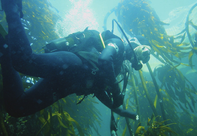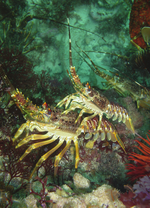The Atlantic Side
‘The Atlantic Side’, as the locals call it, is a totally different diving experience to the rest of Southern Africa. In 2007 the area from roughly Muizenberg in False Bay to Green Point on the Atlantic side was declared a Marine Reserve, thus meaning that the whole of the Cape Peninsula is a protected zone. Scuba divers, therefore, need a dive permit to dive this area.

With the cold Benguela Current moving in a northerly direction to the equator, the water is colder on this side of southern Africa. Here you can experience anything from diving kelp forests, reefs and wrecks. The visibility is all dependent on the weather and can range from just 1M up to 20m. The rule of thumb is that the better the visibility the colder the water, so if you are diving in nice warm waters, expect poor visibility.
Dive sites in the area offers dives for both the beginner and the more advanced diver, while other dive sites have shore entries and others can only be dived by boat. You can often find seals, whales, penguins, dolphins and sharks on the dives.
Summer water temperatures: 12-20˚C.
Winter water temperatures: 8-15˚C.
Noteworthy Dive Spots

Noteworthy dive spots in the Cape Peninsula include:
Coral Gardens - As this site is not often dived and lies within the marine reserve, it is relatively unspoilt and the marine life is prolific. This site is filled with hard and soft corals amongst the fields of Cape urchins and beautiful Sandy anemones in a vast array of pastel colours.
Fish such as Hottentot, Galjoen and other species are plentiful. Chitons, colourful sponges and other invertebrates, as well as Nudibranchs, can be seen at this magnificent site.
Antipolis - The Antipolis is a great shore entry dive site ideal for Open Water divers, as it offers a real wreck experience at a shallow depth. The Antipolis is a 25 000 ton Greek tanker that broke the tow during a storm in 1977. She was on her way to be scrapped and is now lying largely broken up on the reef surrounded by a kelp forest.
The wreck is shallow and accessible with the surface visible at all times – you really get the feeling of being inside the bowels of a shipwreck. In good visibility, the sunrays filter through the turquoise water into the engine room giving divers a magical sight. There is also a sunken bulldozer to see and many large crayfish about. Beware of being sucked into holes when the swell is present.
Clifton Rocks - This dive is situated just off one of the most popular beaches in South Africa – the site is about 75-100 m from the Fourth Beach. Colourful marine growth dominates on and around the rock and there are dense patches of kelp. This area also falls within the marine sanctuary, which means lots of crayfish.
The marine life here is interesting and prolific but not particularly colourful. The kelp cover is thick; many species of invertebrates cover the rocks and hordes of crayfish hide in deep holes. This site is sheltered from even the strongest south-easterly wind.